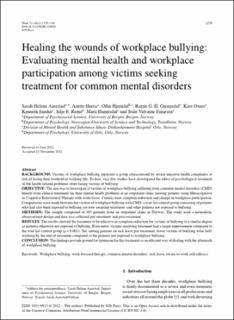Healing the wounds of workplace bullying: Evaluating mental health and workplace participation among victims seeking treatment for common mental disorders
Aarestad, Sarah Helene; Harris, Anette; Hjemdal, Odin; Gjengedal, Ragne Gunnarsdatter Hole; Osnes, Kåre; Sandin, Kenneth; Reme, Silje Endresen; Hannisdal, Marit; Einarsen, Ståle Valvatne
Journal article, Peer reviewed
Published version

Åpne
Permanent lenke
https://hdl.handle.net/11250/3039695Utgivelsesdato
2022Metadata
Vis full innførselSamlinger
Originalversjon
Work : A journal of Prevention, Assesment and rehabilitation. 2022, 73 (4), 1379-1391. 10.3233/WOR-210920Sammendrag
Background: Victims of workplace bullying represent a group characterised by severe negative health complaints at risk of losing their foothold in working life. To date, very few studies have investigated the effect of psychological treatment of the health-related problems often facing victims of bullying.
Objective: The aim was to investigate if victims of workplace bullying suffering from common mental disorders (CMD) benefit from clinical treatment for their mental health problems at an outpatient clinic treating patients using Metacognitive or Cognitive Behavioural Therapy with work-focus. Criteria were symptom reduction and change in workplace participation. Comparisons were made between the victims of workplace bullying with CMD, a wait-list control group consisting of patients who had also been exposed to bullying yet now awaiting treatment, and other patients not exposed to bullying.
Methods: The sample comprised of 405 patients from an outpatient clinic in Norway. The study used a naturalistic observational design and data was collected pre-treatment and post-treatment.
Results: The results showed the treatment to be effective in symptom reduction for victims of bullying to a similar degree as patients otherwise not exposed to bullying. Even more, victims receiving treatment had a larger improvement compared to the wait-list control group (p < 0.001). Yet, among patients on sick leave pre-treatment, fewer victims of bullying were fully working by the end of treatment compared to the patients not exposed to workplace bullying.
Conclusion: The findings provide ground for optimism for this treatment as an efficient way of dealing with the aftermath of workplace bullying.
